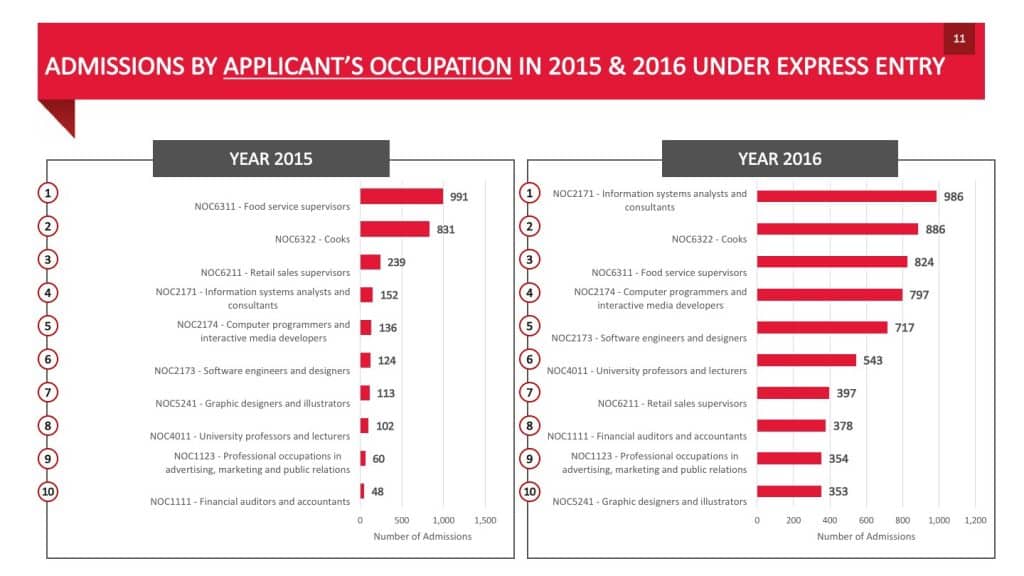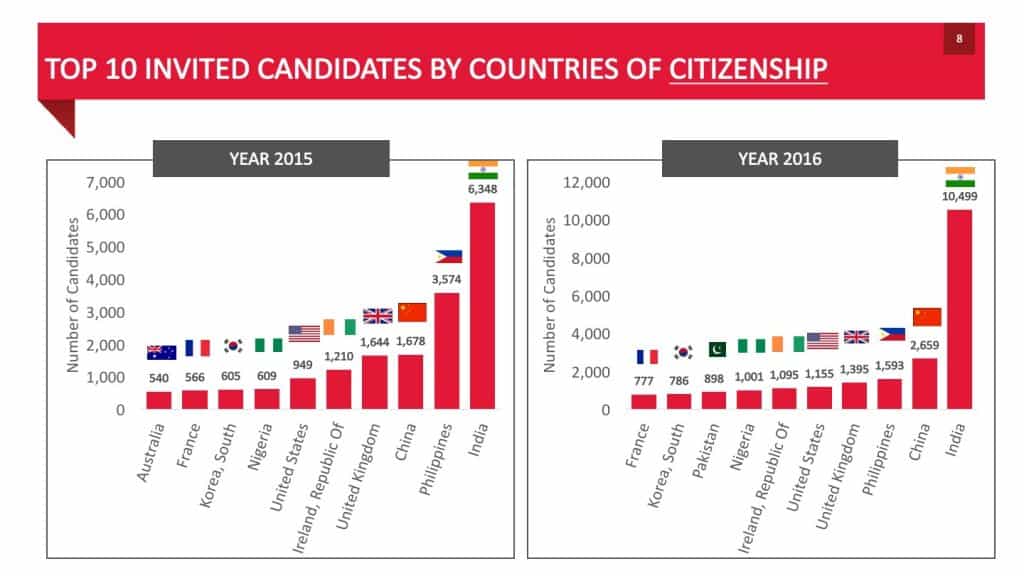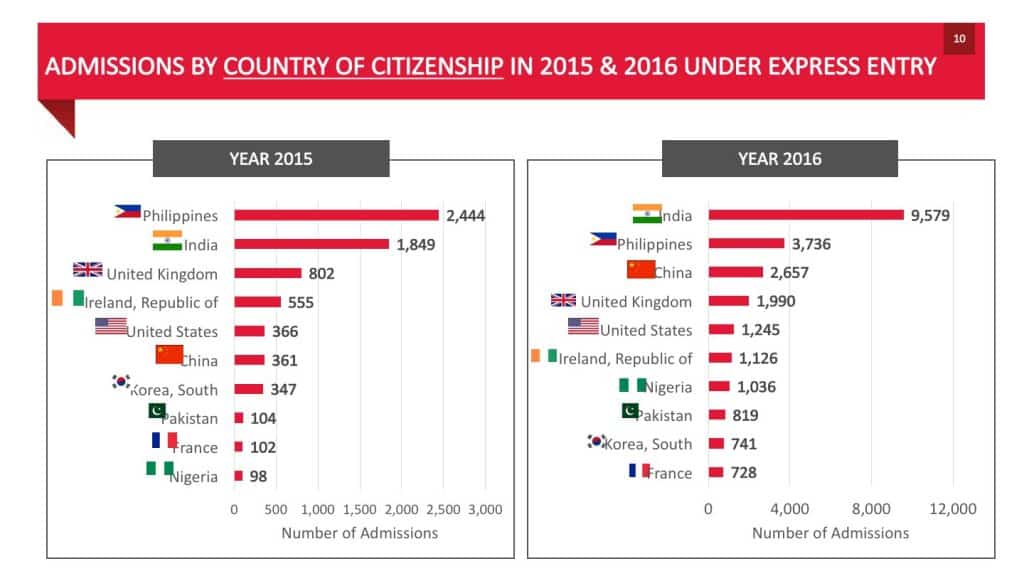April 27, 2017 – The Canada Express Entry immigration system moved through many gears in 2016, as the federal government invited nearly 34,000 candidates to apply for Canada immigration.
 The Express Entry immigration system was designed to allow better flexibility in the management of applications; rapidly respond to Canada’s labour market needs while improving application processing times. It has achieved all three of these objectives. Thus, the Canada immigration model is arguably now at the forefront of global immigration systems.
The Express Entry immigration system was designed to allow better flexibility in the management of applications; rapidly respond to Canada’s labour market needs while improving application processing times. It has achieved all three of these objectives. Thus, the Canada immigration model is arguably now at the forefront of global immigration systems.
Under Canada Express Entry, candidates are invited to apply under three federal economic programs. This includes the Federal Skilled Worker Program, the Federal Skilled Trades Program and the Canadian Experience Class. Part of each Provincial Nomination Program is also covered under the Express Entry system.
Candidates who qualify under any of these programs may submit an application, “expression of interest” into the Express Entry pool. Candidates are given a score based on a range of factors (Comprehensive Ranking System), and are ranked against others in the pool. Those receiving the highest scores are given an invitation to apply for Canadian permanent residence, through periodic draws.
Significantly, 2016 saw an increase in Invitations to Apply (ITAs) by 3,000 from 2015, the first year of the Canada Express Entry management system. The year also saw a large backlog of applications cleared from before Express Entry system began. The vast majority of economic immigrants to Canada will now come through the Express Entry immigration management system.
The flexibility of the system was also illustrated with a number of important changes in how points are distributed. This took effect on November 19, 2016 and it is only in the recent draws in 2017, that the CRS scores reflect those changes, along with new ones made in 2017.
2016 Express Entry Changes
- Reducing points for a qualified job offer from 600 to 200 or 50, depending on the job classification (NOC O,A,).
- Awarding extra points for Canadian education: 15 for a two-year post-secondary course and 30 points for three-years or more, including master’s and doctorate degrees.
- Awarding extra points for candidates already in Canada on work permits exempt from Labour Market Impact Assessments, such as under NAFTA or Mobilité Francophone.
- Changing job offer requirement from indefinite to one year, thus attracting skilled candidates in contract-based sectors.
- Giving candidates 90 days instead of 60 days to complete their applications after receiving an ITA.
Immigration, Refugees and Citizenship Canada (IRCC) released today its 2016 review of Express Entry. Below, the figures and statistics are analyzed as we consider the progression of the Canada immigration Express Entry system from its launch on January 1, 2015.
There were 164,968 new profiles submitted to the Express Entry pool throughout 2016, of which 82,173 were found to be ineligible by immigration authorities. This large drop off of profiles is an ongoing anomaly. On January 1, 2017, there were 58,238 active profiles in the pool, plus 6,610 profiles with outstanding invitations to apply.
Express Entry in 2016 saw significant numbers of ITAs issued towards the start and end of the year, which saw 27 draws. In the early part of the year, the invitation numbers were each in the range of 1,500, with the lowest CRS scores just above 450.

The ITA numbers in each draw dropped off in the middle of the year, which immigration authorities says was due to a concerted effort to process a backlog of applications submitted prior to the launch of Express Entry in 2015.
As the pre-2015 application volume was cleared towards the end of 2016 year, the numbers of ITAs began to grow again, peaking at 2,878, a then record number of invites under Express Entry.
These numbers have continued to grow well into 2017 as the backlog of pre-2015 applications are now cleared.
The federal government also made an important hierarchical change on March 9, 2016.
Before March 9, federal Express Entry candidates had been allocated first to Federal Skilled Workers, followed by Canada Experience Class and Federal Skilled Trades. Some candidates qualified for all three programs.
After March 9, the Canadian Experience Class was prioritized, followed by Federal Skilled Workers and then Federal Skilled Trades.
IRCC says the change did not affect which applicants were issued invitations.
A snapshot provided by IRCC shows the make-up of the Express Entry Pool on January 3, 2017.

This came after changes were made to the Comprehensive Ranking System in November 2016. The effect will continue to be felt well into 2017. One consequence of these changes is that candidates with CRS scores of 850 and above, are likely to have received provincial nomination. This is worth 600 points.
As each draw is made, the number of candidates in the pool, from prior to the November 2016 changes, with high CRS scores, declines. Given that draws are generally conducted every two weeks, sometimes weekly, the composition of the pool quickly changes.
As the number of new entries to the Express Entry pool increases, with corresponding ITAs, CRS scores have gradually but slowly declined as a redistribution of candidate profiles, from the November 2016 continues to take place.
As CRS scores for each draw declines to the range of 400 to 449 points, which has been gradually taking place in 2017, a CRS score reduction of just two or three points can result in thousands more candidates receiving ITAs.

This will serve as a strong motivation for candidates in the lower 400s and upper 300s to pursue efforts to improve their profiles and receive as many points as possible.
The number of ITAs issued by score also illustrates how the CRS score cut-off has fallen and continues to gradually, slowly but steadily fall.
By the end of 2016 CRS scores in a given draw had never fallen below 450. As the federal government looks to meet its economic immigrant target levels of more than 72,000 in 2017, the CRS score in the most recent draw has already dropped to 415 points.
This brings into consideration a whole new profile of immigration candidate to Canada.
Provincially, the emergence of the provinces participating in the Express Entry system under PNPs is central to the future success of Express Entry system. For 2016, this was supported by the statistics.
Following the November 2016 changes, provincial nomination has become the only route to receiving 600 points, which effectively guarantees a candidate of receiving an ITA.
IRCC numbers show an increase of more than 7,000 Canada immigration applications received in 2016, with PNP approvals, compared with 2015.
How those applications were distributed is also important to analyze. Alberta, British Columbia and Ontario dominated the number of applications received in both 2015 and 2016.
However, while B.C. and Ontario chose to nominate almost 6,000 immigrants between them in 2016, Alberta nominated only two, with effectively all of its Express Entry applications coming via federal programs.
Both B.C. and Ontario still saw the majority of its applicants come via the CEC, FSW and FST programs, with the opposite true for several other provinces.
In Saskatchewan, Nova Scotia, New Brunswick and Prince Edward Island, provincial nominations dominated the overall numbers with the federal programs playing a minor role.
This shows the benefits of Express Entry for the provinces to select immigrants specific to their economic needs and draw candidates away from the major population centres.
Previously, the four mentioned provinces would have been among those struggling to attract applications. Under Express Entry, the 600 points available for their nomination means they can now play an important role to recruit candidates for provincial employers.
As a side note, on at least one occasion the federal government has chosen to conduct draws exclusively for the provincial nominee class.
This was done for the draw immediately after the November 2016 changes were made in order to clear out the higher scoring candidates and rebalance the profiles in the Express Entry pool.
It is worth noting that Ontario significantly increased its admission numbers in 2016, accounting for 37 per cent of the total admissions through Express Entry. In 2015, the figure was only 23 per cent.
The top 10 occupations invited through Express Entry took on a significantly different look in 2016 compared with 2015.
In 2015, food service supervisors and cooks accounted for a combined 16 per cent of the total ITAs issued, when a qualified job offer scored 600 points.
In 2016, the two occupations were still the fourth and fifth most popular occupations for ITAs. However, the proportion of the total declined from a combined 16 per cent to 7 per cent, or from more than 4,650 candidates to 2,233.


Changes made to the CRS scores for a job offer in November 2016 were explained by a drive to get more candidates with a broader range of applicable skills, education and experience receiving ITAs.
Candidates with a wider range of ‘core’ factors are seen as having a longer-term benefit to the Canadian economy.
In 2016, technology-related occupations accounted for the top three in terms of ITAs, with a combined 14 per cent of the total, up from 10 per cent in 2015.
Given the shortage of such high-skilled workers in the Canadian labour force, these results will have been more in line with the targets of IRCC.
With larger draw sizes and falling CRS scores in 2017, the range of occupations is expected to broaden.
The top 10 occupations in 2016 made up 31 per cent of the total ITAs, compared with 38 per cent in 2015. This indicates the beginning of the broadening as a result of the lower job offer points available.
Admission figures by occupation in 2015 and 2016 illustrate both the broadening effect of the points change and the shift towards technology workers.

In 2015, figures show cooks and food service supervisors represented 31 per cent of admissions, dropping to nine per cent in 2016.
This can be explained by the many food industry staff who in 2015, were already working in Canada under the Temporary Foreign Worker Program, (TFWP), when a job offer was worth 600 points.
IRCC estimates it takes between 12 and 18 months for an immigration candidate to arrive in Canada from the time an ITA is issued. Therefore, the full extent of changes to how points are awarded post November 2016, will continue to emerge with statistics compiled from future draws.
Canada dominates the country of residence of invited candidates in both 2015 and 2016, although the proportion declines from 78 per cent to 69 per cent respectively between the two years.
This illustrates how temporary foreign workers dominated the earlier Express Entry draws because of their access to job offers and wish to settle permanently in Canada.
Given the reduction in points for a job offer and the falling CRS scores that is occurring in 2017, it is anticipated the countries of residence list will change significantly in the coming months.


A better indication of the origin of candidates is the citizenship of those admitted, which was dominated by Indian citizens in 2016 after new immigrants from the Philippines led the way in 2015.
Nearly a third of the total 2016 admission cohort had Indian citizenship, up from less than 20 per cent in 2015. The Philippines total, meanwhile, dropped sharply from 25 per cent to 11 per cent.

The dominant countries on this list are not expected to wildly vary, given the likes of India and Philippines are well established as feeder countries to Canada along with some developed nations.
If 2016 was a ground-breaking year for Express Entry, 2017 is only continuing in that trend.
The first 10 draws of 2017 through April 19 have seen 35,993 ITAs issued, already surpassing the cumulative total figures for both 2015 and 2016.
Draws have consistently seen more then 3,500 ITAs issued, with the current record high seen on March 1, 2017, when 3,884 candidates were invited to apply.
The minimum CRS score has also fallen, with the April 19 draw setting a new record low of 415.
The reasons for such a dramatic increase are four-fold.
- Immigration, Refugees and Citizenship Canada aims to receive near the upper target of 77,000 in its annual immigration levels for economic class immigrants.
- The government now has a much clearer picture of how ITAs relate to submitted applications. It has two years of data showing how many candidates received ITAs but failed to submit their applications. The relationship between ITAs, completed applications and immigrants arriving in Canada is a key driver when setting ITA numbers. Figures show that approximately 38% of candidates who receive an ITA, do not submit a perfected application for permanent residence within required delays.
- The time it takes to complete an application from the date of an ITA, with the target being six months for those working in Canada, and between 12-18 months for candidates outside Canada. As such, IRCC is aware it must issue a certain number of ITAs during specified quarters so that those invited arrive inside a calendar year to meet annual immigration levels. This was also part of the reason behind the increase in ITAs at the end of 2016. These candidates will be figured against the 2017 immigration targets.
- The backlog of applications from the pre-2015 period prior to Express Entry, are now almost all cleared. This means that sometime soon every new federal economic class permanent resident will come through Express Entry.
Given the above considerations, federal immigration authorities will need to issue more than 60,000 ITAs to reach the 77,000 -upper target for the 2017 immigration levels under the Economic Class. (For each application for permanent residence, there are approximately 2.2 individuals being admitted to Canada, on average).
To do this, draw sizes will need to be maintained well above 3,000, with CRS scores continuing to decline. It is very likely that many candidates with scores under 400 will receive an ITA under Express Entry in 2017.
This means candidates outside Canada with more diverse profiles now have a strong chance of receiving an ITA in 2017. Previously, applicants from overseas were required to have a master’s or doctorate degree, in addition to being under age 30 with high English or French proficiency. In 2017, many principal applicants outside Canada with a bachelor’s degree, strong language proficiencies and other attributes will receive ITA’s. It is anticipated that more than 40% of invitations will be issued to candidates residing outside Canada. This could perhaps become one of the more interesting highlights for 2017.
Conclusion
The message is clear to Express Entry candidates both already in the pool or preparing to submit applications. It is now more important than ever for candidates to try and maximize the points available to them as the minimum CRS score progressively declines. Securing an approved job offer, becomes a make or break factor for thousands of candidates with CRS scores in the 300’s.
With further important changes to the Comprehensive Ranking System score planned for June 2017, candidates are urged to keep on top of new developments.
In the opening months of 2017, Express Entry records have already been broken. This trend will likely continue during the next second quarter and perhaps stabilize.
What this means for employers
Employers are encouraged to consider securing an LMIA or nomination under provincial nomination programs (PNP’s) to ensure long term retention of employees. A number of employees may also qualify for permanent residence, under Express Entry, who are working in Canada under LMIA exempt work permits, such as NAFTA.We provide Canadian employers with unparalleled immigration legal services and recruitment of foreign nationals through our in-house enterprise Global Recruiters of Montreal (www.grnmontreal.com). We bring approved candidates to Canada in the shortest time possible. Employers in a wide range of industries can directly benefit from our unique position as one of Canada’s leading immigration firms in the industry to meet both their recruitment and immigration requirements.
Interested employers wishing to seek our assistance are invited to contact us here for further information.
What this means for candidates
It is expected that the majority of applicants to be issued (ITA’s) under Canada’s Express Entry Immigration system in 2017 will require a CRS score well under 450 points, enabling a significant number of applicants to receive permanent admission to Canada without a job offer or nomination under a provincial immigration program. However, securing an approved offer of employment is highly recommended.A growing number of candidates will qualify under Express Entry from outside Canada. Many can expect to receive an ITA, with a bachelor’s degree and other attributes.
Additionally, as mentioned at the start of this analysis, there were 164,968 new profiles submitted to the Express Entry pool throughout 2016, of which 82,173 were found to be ineligible by immigration authorities. Many of these candidates may qualify for admission to Canada under our in-house employment based residence program.
Find out whether you qualify to Canada by completing our free on-line evaluation. We will provide you with your evaluation results within 1-2 business days.





